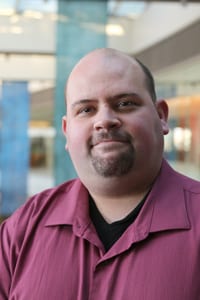
Kevin Eliceiri, Morgridge Institute investigator and professor of biomedical engineering and medical physics at the University of Wisconsin–Madison, is the lead investigator on a $1.2 million grant from the Chan Zuckerberg Initiative (CZI) in support of the imaging expertise network known as BioImaging North America (BINA).
BINA brings together the bioimaging community in Canada, the United States and Mexico. They work closely with individuals and core facilities to formulate meaningful partnerships that provide guidance, assistance, training opportunities, data sharing and technology dissemination to the community. Eliceiri also serves on the executive committee of BINA, along with lead members from eight other research entities.
“We wanted to have a well-organized training and dissemination network across the United States and our North American partners,” says Eliceiri. “In part, it was inspired by all the wonderful things happening in Europe and Australia where there already were consortiums, such as Euro Bioimaging where many European countries got together to do such a training network. BINA to date has largely been a grass roots effort here in North America to create an imaging training and expertise network, and the CZI funding will greatly help foment our activities.”
Eliceiri’s personal research entails building microscopes and developing software at both Morgridge and UW–Madison. As his career progressed, Eliceiri has increasingly done more and more work with developing novel software for quantitating images. He is co-lead investigator of an NIH funded collaborative center at the UW that is dedicated to developing open source software for image analysis which heavily involves both UW and Morgridge investigators.
It was Eliceiri’s passion for community building at both Morgridge and UW–Madison that helped motivate him to join BINA in order to do more mentoring and training that he had been doing very informally as a side effort of his current research.
“When I saw the opportunity to help create a national imaging community, I thought there was no better place than Morgridge, which has already put an emphasis on building scientific expertise communities.”
Kevin Eliceiri
“In the case of CZI, I don’t really consider them just a funder, but more of a partner,” says Eliceiri. “They’ve had a lot of major input and great ideas about how to move BINA forward.”
The Executive Committee of BINA emphasizes the community building aspect that they hope to improve by bringing on paid staff for improved organization and increased efforts. Eliceiri’s contribution to build community locally primed him for expanding efforts nationwide.
“I have an investigator home in Morgridge, and one of my Morgridge roles was to build an imaging community across campus, that includes current Morgridge investigators Melissa Skala and Jan Huisken,” says Eliceiri. “So when I saw the opportunity to help create a national imaging community, I thought there was no better place than Morgridge, which has already put an emphasis on building scientific expertise communities.”
The CZI grant was written with largely the intention of hiring two new staff members—an experienced program director and an administrator to aid the BINA organization. The remaining funds will be used for training kits, conferences and travel, but the two staff are the main component. Both staff will be housed within the Morgridge Institute.
